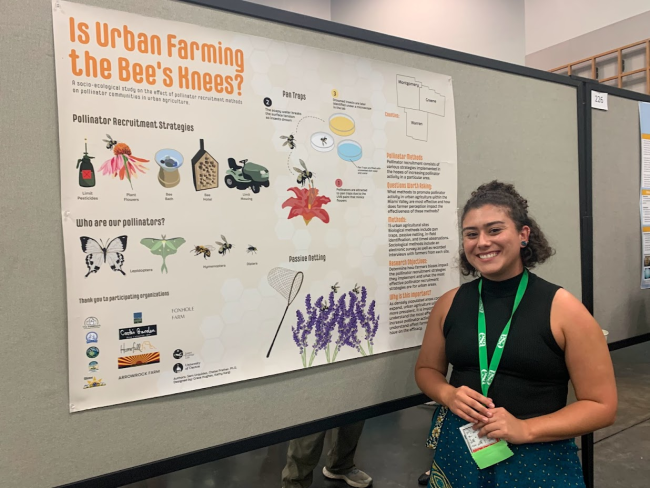You have /5 articles left.
Sign up for a free account or log in.

Biology students at the University of Dayton in Ohio partnered with graphic design students to create interesting research posters.
Chelse Prather/University of Dayton
Interdisciplinary collaboration can help students gain exposure to ideas and processes outside of their major as well as improve their discipline-specific assignments. One faculty member at the University of Dayton in Ohio wanted to improve her biology students’ research presentation skills and joined forces with a graphic design professor to do so.
Chelse Prather, an associate professor biology, recognized a need to teach students how to lay out and organize their content.
“Science communication historically is bad because scientists don’t know how to present things visually and make it appealing and digestible to the layperson,” Prather explains.
Most research posters in biology have a white background, a title in standard size and three columns of information on the introduction, result and conclusion. While not a bad format, “I thought there had to be a more engaging way for students to present their research,” Prather adds.
She teamed up with Kathy Kargl, a senior lecturer of graphic design at the university. The faculty paired up their students to flesh out student research into a poster that would be colorful, eye-catching and yet still clear to understand.
How it works: The biology students were responsible for first creating all of the chart content, including written text and relevant charts, as they would typically. Then, they met with a graphic design student a few times over a few weeks, Prather says.
Biology student Sam Urquidez created a chart based on his research on bees and urban farming. Working alongside graphic designer Grace Hughes, Urquidez created a final poster featuring images of pollinator recruitment strategies, pollinators, pan traps and passive netting, which were all critical components of the research, in addition to the typical sections such as methods and research implications.
Each specialized poster was presented at the university’s undergraduate research symposium alongside a more basic format, which the biology student created independently.
The impact: During the research symposium, Prather and students surveyed attendees to gauge their preference for the poster, both in engagement and delivery of content. Overall, those in the sciences were more likely to say they preferred the traditional-style poster, but all other viewers enjoyed the collaborative piece.
Students in the class enjoyed the collaboration as well, according to end-of-course assessments, with biology students appreciating a new way to reveal their work and graphic designers learning more about their peers’ research topics and work.
The practice could be used for scientists and researchers in a variety of departments who want to improve their presentation, Prather says. One tip she’s learned is to devote some class time to helping students explain their charts and graphs to nonscience majors, who might not be as familiar with them or able to read them.
Artistic Collaborations
A pair of music education students at Central College partnered with peers in the art department to design and illustrate student-authored music books, which feature a story and basic songs for elementary-aged students. The books were printed and sold online, and each student got a copy to display in their own classroom.
Seeking stories from campus leaders, faculty members and staff for our Student Success focus. Share here.








